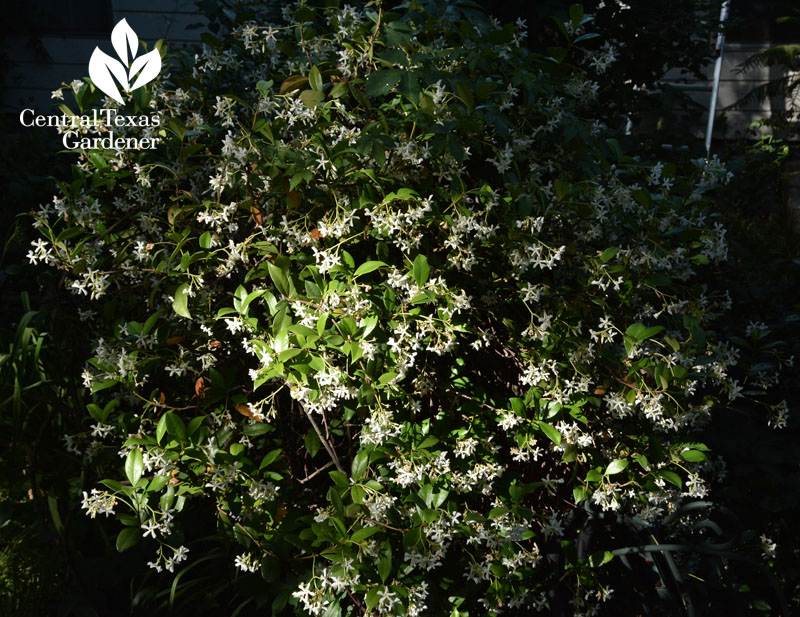May 7, 2015
Healing plants & safe edibles for us & wildlife
At a time that bees and butterflies are troubled, I’m certainly glad I’ve got things to eat for them. Right now, they’re going for my star jasmines, shaped as “shrubs” near my patio where I can get a good sniff.

And you bet, I love my native Penstemon cobaeas for that pop-out white in part shade/ sun. Nice deal that the bees love them, too.

Earlier, my native Salvia lyrata seeded itself quite happily on my back patio. Everybody happy about that!

I’m thrilled that some of my neighbors are on the bandwagon, since feeding wildlife is really a village kind of thing. A few blocks over, bees were all over Desert Bird of Paradise (Caesalipinia gillessii).

These folks took out a lot of lawn at their hot curb strip with native ground cover, silver ponyfoot (Dichondra argentea). What a great accent to Jerusalem sage (Phlomis fruticosa) for pollinators!

To keep the menu going in summer, almond verbena (Aloysia virgata) does the trick with vanilla-fragranced flowers all summer.

Daphne makes perennial almond verbena her Plant of the Week for its shrubby, deer-resistant, drought defiant qualities. Deciduous in winter, it’s best to cut it back near the base in early spring to promote a fuller figure.

Shrubby native Bee-brush (Aloysia gratissima) is another sweet option for sun to part shade.

Jay Beard from wholesale Lone Star Nursery’s growing some surprising beneficial plants for us and wildlife.

One is tea tree (Melaleuca alternifolia); you know, the oil we buy as a natural antiseptic. We can grow this evergreen sun-lover right here! We can’t distill for the oil, but we sure can use the leaves in an antifungal poultice.

Canna edulis is another Jay grows for its edible rhizomes. Be sure to get the edulis!

Jay’s also growing organic-from-seed (no neonicotinoids!) plants for butterflies and bees. Native frostweed (Verbesina virginica) makes a lovely backdrop in deeply shady areas, exploding with flowers in fall for all butterflies and migrating Monarchs.

We’ll all been looking for native milkweeds! Jay’s growing Green antelopehorn (Asclepias viridis) and Antelope horns (Asclepias asperula), available soon at The Natural Gardener. Do check, since there’s a waiting list.

Lone Star Nursery’s other unique plants are available at: The Great Outdoors, Wheatsville, BRITE Ideas, King Feed in Wimberley, Round Rock Gardens, Red Barn, and Georgetown Farm Supply. Find out more!
In spring, native coral honeysuckle (Lonicera sempervirens) feeds hummingbirds, bees, and butterflies, like this one on Kathy Faul’s patio vine in Moody.

Since she’s got a bird’s eye view from indoors, she can watch the mockingbirds and cardinals raise their young snuggled in its vining safety. Later, she can watch birds snag the fruits.

But, this deer-resistant vine for sun to part shade needs some wrangling now and then to keep it lush.
Get Daphne (and Kathy’s) tips for when and how to shape coral honeysuckle.

Viewer Picture goes to Comal County Master Gardener Charlotte Trussell for her pair of cutie bluebirds. Mexican buckye behind them feeds lots of wildlife all year.

John Dromgoole feeds our soil (and us) with summertime cover crops. Buckwheat, cream peas, purple hull peas and black-eyed peas return nitrogen to the soil for our winter crops and keep weeds at bay in fallow vegetable beds. And, he tells us that you can even plant some of your dried grocery store peas!

On tour, the Compost Pedallers cycle to recycle our kitchen scraps and other household waste to nourish local farms. See why they’re doing it and what you can recycle into your compost pile.
Thanks for stopping by! See you next week, Linda
tags:
- Bees
- Butterflies
- butterfly plants
- Central Texas
- Comal Master Gardeners
- Compost Pedallers
- coral honeysuckle
- Cover Crops
- Daphne Richards
- Deer Resistant Plants
- Drought Resistant Plants
- Groundcover
- Jay Beard
- John Dromgoole
- Lone Star Nursery
- milkweed
- Native Plants
- Perennials
- pruning vines
- recycle
- Spring Flowers
- tea tree
- The Natural Gardener
- viewer pictures
- Wildlife Plants and Habitat

